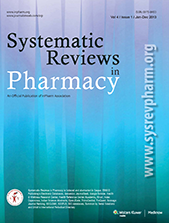Leucas aspera ? A Review of its Biological activity
Abstract
Antimicrobial activity, Antioxidant, Herbal plant, Medicinal value, Indian medicinal plant.
Herbal plants are integral parts of the traditional medicine worldwide and most of the rural and urban population uses these plants in many of their regular needs even today. The current researchers are more focused on natural chemicals than the synthetic chemicals due to their environmental, economical and health benefits. Plants produce many chemical compounds for its biological activities including defence mechanism against microbes, insects and herbivorous animals and these chemicals are called as phytochemicals. Herbal plants are a natural source of many important phytochemicals and widely used in Pharmaceutical, food and cosmetic industries. A wide variety of herbal plants are available in the Indian subcontinent and they are the backbone of Indian traditional medicines Ayurveda and Siddha. Leucas aspera Linn., commonly known as Thumbai or Dronpushpi is a small, erect, branched annual aromatic herb, distributed throughout India from the Himalayas down to Ceylon. Though it grows as a weed throughout the country, it has a number of medicinal values and it is used in traditional medicine to treat many diseases. The study of various biological properties of this plant will be useful for its potential use in respective industries. Medicinally, it has been proven to possess various pharmacological values like antifungal, antipyretic, antioxidant, antimicrobial, antinociceptive, analgesic, antidiarrheal, insecticidal, antiinflammatory and cytotoxic activity in a number of studies by different researchers in the past several years. The available reports on antimicrobial activity, antioxidant activity and pharmacological value of L. aspera are discussed in this review.
| How to Cite this Article |
| Pubmed Style Nirmala KA, Kanchana M. Leucas aspera – A Review of its Biological activity. SRP. 2018; 9(1): 41-44. doi:10.5530/srp.2018.1.8 Web Style Nirmala KA, Kanchana M. Leucas aspera – A Review of its Biological activity. http://www.sysrevpharm.org/?mno=302644546 [Access: March 28, 2021]. doi:10.5530/srp.2018.1.8 AMA (American Medical Association) Style Nirmala KA, Kanchana M. Leucas aspera – A Review of its Biological activity. SRP. 2018; 9(1): 41-44. doi:10.5530/srp.2018.1.8 Vancouver/ICMJE Style Nirmala KA, Kanchana M. Leucas aspera – A Review of its Biological activity. SRP. (2018), [cited March 28, 2021]; 9(1): 41-44. doi:10.5530/srp.2018.1.8 Harvard Style Nirmala, K. A. & Kanchana, . M. (2018) Leucas aspera – A Review of its Biological activity. SRP, 9 (1), 41-44. doi:10.5530/srp.2018.1.8 Turabian Style Nirmala, Kulandaisamy Agnes, and Marimuthu Kanchana. 2018. Leucas aspera – A Review of its Biological activity. Systematic Reviews in Pharmacy, 9 (1), 41-44. doi:10.5530/srp.2018.1.8 Chicago Style Nirmala, Kulandaisamy Agnes, and Marimuthu Kanchana. "Leucas aspera – A Review of its Biological activity." Systematic Reviews in Pharmacy 9 (2018), 41-44. doi:10.5530/srp.2018.1.8 MLA (The Modern Language Association) Style Nirmala, Kulandaisamy Agnes, and Marimuthu Kanchana. "Leucas aspera – A Review of its Biological activity." Systematic Reviews in Pharmacy 9.1 (2018), 41-44. Print. doi:10.5530/srp.2018.1.8 APA (American Psychological Association) Style Nirmala, K. A. & Kanchana, . M. (2018) Leucas aspera – A Review of its Biological activity. Systematic Reviews in Pharmacy, 9 (1), 41-44. doi:10.5530/srp.2018.1.8 |






